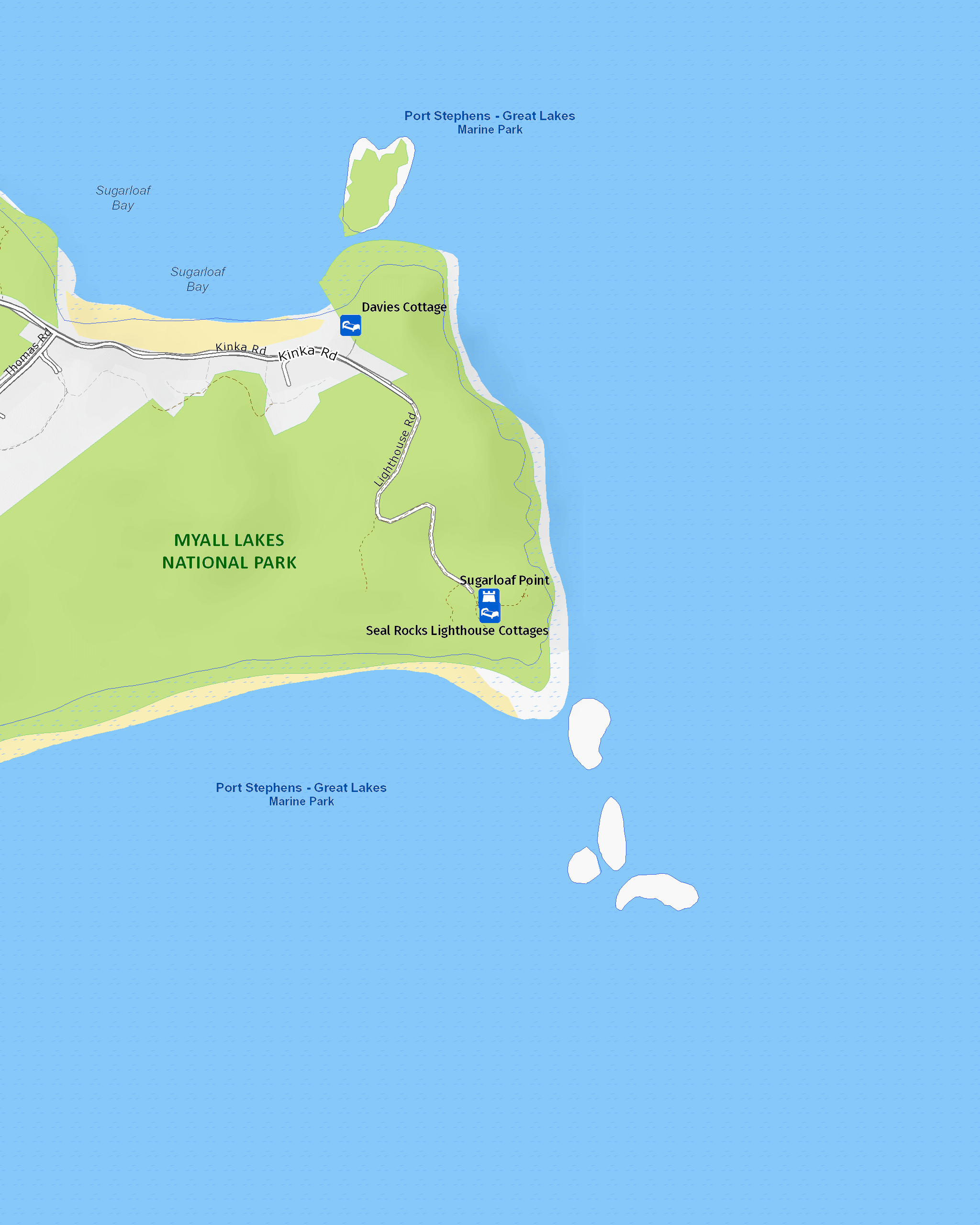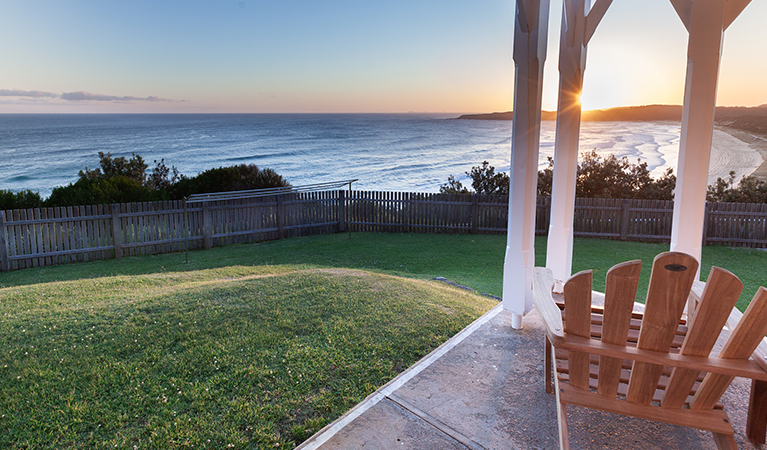Overview
Seal Rocks Lighthouse Cottages in Myall Lakes National Park offer heritage accommodation surrounded by stunning views. It's a great place for a romantic weekend getaway.
| Accommodation type | Cottage |
|---|---|
| Where | 75-77 Lighthouse Road, Seal Rocks, NSW, 2423 - in Myall Lakes National Park |
| Bedrooms | 7 |
| Maximum guests | 20 |
| What to bring | Food supplies |
| Entry fees | Park entry fees apply |
| Please note | Bedding configuration:
|
Located in Myall Lakes National Park, the award-winning Seal Rocks Lighthouse Cottages are the ultimate weekend getaway. Built in 1875 and carefully refurbished, these historic cottages offer self-contained heritage accommodation in a truly spectacular location.
Each cottage features an outdoor area from which you can enjoy breathtaking panoramas, cook up a barbecue feast or enjoy a meal with a view.
Aside from being an idyllic place to spend a weekend, the cottages are also a great base to explore the coastal town of Seal Rocks and the walking tracks and beaches of Myall Lakes National Park.
Map

Map legend

Local alerts
For the latest updates on fires, closures and other alerts in this area, see https://www.nationalparks.nsw.gov.au/camping-and-accommodation/accommodation/seal-rocks-lighthouse-cottages/local-alerts
General enquiries
- National Parks Contact Centre
- 7am to 7pm daily
- 1300 072 757 (13000 PARKS) for the cost of a local call within Australia excluding mobiles
- parks.info@environment.nsw.gov.au
Operated by
- Seal Rocks Lighthouse Cottages
- 7 days, 9am to 5pm
- 02 4997 6590
- stay@srlc.com.au
- 75-77 Lighthouse Road, Seal Rocks NSW 2423
Park info
- in Myall Lakes National Park in the North Coast region
Myall Lakes National Park is always open but may have to close at times due to poor weather or fire danger.
-
Park entry fees:
$8 per vehicle per day.
Day passes are available from a card operated pay machine at Mungo Brush campground or from the Manning Great Lakes Area Office. You can also pay for your visit via the Park’nPay app. You’ll need a Day Pass or Annual Pass when visiting the park.
Bombah Point ferry fees may also apply (cash payment only).
Buy annual pass.
Visitor info
All the practical information you need to know about Seal Rocks Lighthouse Cottages.
Getting there and parking
Seal Rocks Lighthouse Cottages are located on Kinka Road in the Sugarloaf Point to Shelly Beach precinct of Myall Lakes National Park. To get there, take The Lakes Way from the Pacific Highway, then take Seal Rocks Road to Sugarloaf Point.
Road quality
- Unsealed roads
Vehicle access
- 2WD vehicles
Weather restrictions
- All weather
Parking
Parking is available at Seal Rocks Lighthouse Cottages. Two spaces per cottage are available.
Best times to visit
There are lots of great things waiting for you in Myall Lakes National Park. Here are some of the highlights.
Autumn
A good time to visit when the weather is a little cooler and the park is less busy.
Spring
Magnificent wildflower displays as they bloom across the heathlands.
Summer
Look for dolphins swimming among the waves.
Winter
Head to Sugarloaf Point to watch for whales on their annual migration.
Weather, temperature and rainfall
Summer temperature
Average
19°C and 27°C
Highest recorded
41.5°C
Winter temperature
Average
10°C and 19°C
Lowest recorded
1.1°C
Rainfall
Wettest month
May
Driest month
November
The area’s highest recorded rainfall in one day
257.8mm
Maps and downloads
Prohibited
Pets
Pets and domestic animals (other than certified assistance animals) are not permitted. Find out which regional parks allow dog walking and see the pets in parks policy for more information.
Smoking
NSW national parks are no smoking areas.
Learn more
Seal Rocks Lighthouse Cottages is in Myall Lakes National Park. Here are just some of the reasons why this park is special:
Ancient connections

Myall Lakes National Park is part of the Country of the Worimi Aboriginal people, who used the area's natural resources, like freshwater lakes, the ocean and native flora and fauna to live a traditional fisher-hunter-gatherer lifestyle. Much evidence of their long connection with this Country can be seen today throughout the middens in the park. The landscape of Myall Lakes includes important spiritual sites that are an important part of the identity of local Aboriginal people. Make sure you visit Dark Point Aboriginal Place while you're at visiting the park. This rocky headland has been of significance to Worimi people for at least 4000 years. The clans or nuras (family groups) within the Worimi people would gather together here for ceremonies and feasts.
- Dark Point Aboriginal Place Dark Point Aboriginal Place, in southern Myall Lakes National Park, is a culturally significant site for the Worimi people with scenic coastal views across to Broughton Island.
- Mungo walking track Mungo walking track offers a variety of Aboriginal and historic sites, diverse vegetation, and mountain biking in Myall Lakes National Park, near Hawks Nest.
Go fish

Fishing is a popular activity in Myall Lakes, with catches likely to include bream, whiting, Australian salmon, flathead and mullet. There are lots of great places in the park to throw in a line, like the beaches, lakes or rivers. Try fishing from your boat or for a relaxing day on the water you could try a spot of kayak fishing. At Myall Lakes you can also go camping, boating, swimming and canoeing. And when you’ve tried all of those, you can explore the park on foot, by 4WD or bike, stopping for a spot of bird watching or to enjoy a picnic or barbecue lunch along the way. Whatever your interests, there is bound to be something that takes your fancy.
- Mining Road to Old Gibber Road cycling trail Mining Road to Old Gibber Road cycling trail is an easy bike ride within Myall Lakes National Park. You can complete the ride in one day or take your tent to camp overnight.
- Mungo Rainforest walk Enjoy a short and easy rainforest walk with the birds in Myall Lakes National Park, not far from Buladelah. Afterwards, you can enjoy a picnic or barbecue at Mungo Brush.
Internationally recognised wetlands

Since 1999, this internationally recognised wetlands site, has been listed under the Ramsar Convention due to its diverse mosaic of near-natural wetlands, within a relatively unmodified coastal lake system. There are 18 different wetland types with extensive interconnected lake and river systems within the forested wetlands and swamps that fringe the waterways, rocky and sandy shores, and offshore islands off the coastline. This wetland site houses a complex variety of habitats with rich biodiversity, including threatened species and migratory birds protected under international agreements. The Myall Lakes wetlands also have a high cultural and social value as they occur within the traditional lands of the Worimi Aboriginal people, where the varied wetlands, environments and abundant resources provided an ideal living environment. Evidence of this traditional occupation exists across the landscape, including the Dark Point Aboriginal Place.
Plants and animals protected in this park
Animals
-

White-bellied sea eagle (Haliaeetus leucogaster)
White-bellied sea eagles can be easily identified by their white tail and dark grey wings. These raptors are often spotted cruising the coastal breezes throughout Australia, and make for some scenic bird watching. Powerful Australian birds of prey, they are known to mate for life, and return each year to the same nest to breed.
-

Long-nosed bandicoot (Perameles nasuta)
A nocturnal marsupial and one of the smaller Australian native animals, the long-nosed bandicoot is found across eastern Australia. Populations in the Sydney region have dwindled since European settlement, leaving only endangered colonies in inner western Sydney and at North Head, near Manly. The long-nosed bandicoot has grey-brown fur and a pointed snout which it uses to forage for worms and insects.
-

Brown-striped frog (Lymnastes peronii)
One of the most common frogs found in Australia, the ground-dwelling brown-striped frog lives in ponds, dams and swamps along the east coast. Also known as the striped marsh frog, this amphibian grows to 6.5cm across and has a distinctive ‘tok’ call that can be heard all year round.
-

Grey-headed flying-fox (Pteropus poliocephalus)
The grey-headed flying fox is Australia's largest native bat, with a wingspan up to 1m. This threatened species travels up and down south-eastern Australia and plays a vital role in pollinating plants and spreading seeds in our native forests.
-

Green and golden bell frog (Litoria aurea)
The green and golden bell frog is an endangered Australian frog. Once common on the NSW coast and tablelands, populations have plummeted around 90 percent.
Plants
-

Cabbage palm (Livistona australis)
With glossy green leaves spanning 3-4m in length and a trunk reaching a height of up to 30m, the cabbage tree palm, or fan palm, is one of the tallest Australian native plants. Thriving in rainforest margins along the east coast of NSW, in summer this giant palm produces striking spikes of cream flowers which resemble cabbages.
-

Wonga wonga vine (Pandorea pandorana)
The wonga wonga vine is a widespread vigorous climber usually found along eastern Australia. A variation of the plant occurs in the central desert, where it resembles a sprawling shrub. One of the more common Australian native plants, the wonga wonga vine produces bell-shaped white or yellow flowers in the spring, followed by a large oblong-shaped seed pod.

